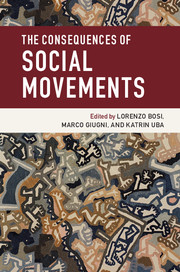Book contents
- Frontmatter
- Contents
- List of figures
- List of tables
- List of contributors
- Introduction
- Part I People
- 2 All is not lost: the 1984–85 British miners’ strike and mobilization after defeat
- 3 Personal effects from far-right activism
- 4 The biographical impact of participation in social movement activities: beyond highly committed New Left activism
- 5 Examining the intergenerational outcomes of social movements: the case of feminist activists and their children
- 6 Aggregate-level biographical outcomes for gay and lesbian movements
- Part II Policies
- Part III Institutions
- Conclusion
- Index
- References
3 - Personal effects from far-right activism
from Part I - People
Published online by Cambridge University Press: 05 January 2016
- Frontmatter
- Contents
- List of figures
- List of tables
- List of contributors
- Introduction
- Part I People
- 2 All is not lost: the 1984–85 British miners’ strike and mobilization after defeat
- 3 Personal effects from far-right activism
- 4 The biographical impact of participation in social movement activities: beyond highly committed New Left activism
- 5 Examining the intergenerational outcomes of social movements: the case of feminist activists and their children
- 6 Aggregate-level biographical outcomes for gay and lesbian movements
- Part II Policies
- Part III Institutions
- Conclusion
- Index
- References
Summary
Scholars agree that participating in social movements has significant effects on activists, shaping their attitudes, identities, political involvement, and life choices long into the future. If there is consensus that activism affects a person's life, however, it is less clear how this happens. I tackle this issue by focusing on the processes – that is, the steps or causal chains – by which long-term personal consequences flow from participating in social movements. Using an interpretive approach, this study introduces a model of narrative-based counterfactual logic to explore how activists’ understandings of themselves and their political involvement mold their sense of alternatives and lead to enduring consequences. While most studies of individual consequences of movement participation focus on those with progressive politics or, at least, democratic agendas (Bosi and Uba 2009), this study looks at the outcomes of participating in far-right movements in the United States, specifically the racist movements of neo-Nazis and the Ku Klux Klan (KKK).
Some studies suggest that personal outcomes might not differ much between rightist activists and those in progressive movements. Movements of the left and right share similar characteristics in how they mobilize participants, frame issues, forge collective identities, create solidarity, and develop goals and strategies (Blee 2002, 2012; Blee and Creasap 2010; Bosi and Giugni 2012), so they should have similar effects on activists. Other studies, however, suggest that the outcomes for far-right activists might be different than for their leftist counterparts, even on the far-left, due to right-wing support for social hierarchies, distrust of democracy, and disdain for the broader public. Because racist groups regard virtually all whites – outside a small set of committed members and those targeted for recruitment – as potential “race traitors” hostile to the white race (Blee 2002) and rarely measure success by public support (Bosi and Giugni 2012; Giugni 1998), they instill in their members a sense of victimization and fear of the larger society that makes it difficult for them to sustain social ties with those outside the far-right or to reenter mainstream life after they leave racist groups (Blee 2009a, 2009b; Simi and Futrell 2010).
Conceptual framework
This chapter argues that the personal outcomes that flow from movement activism can be understood by looking closely at how people experience themselves as activists and post-activists. Four distinct literatures provide the conceptual framework. First, I draw from the extensive scholarship on narrative.
- Type
- Chapter
- Information
- The Consequences of Social Movements , pp. 66 - 84Publisher: Cambridge University PressPrint publication year: 2016
References
- 16
- Cited by



